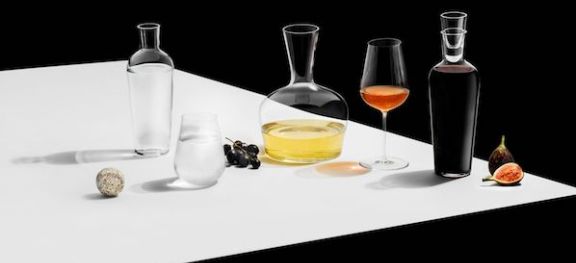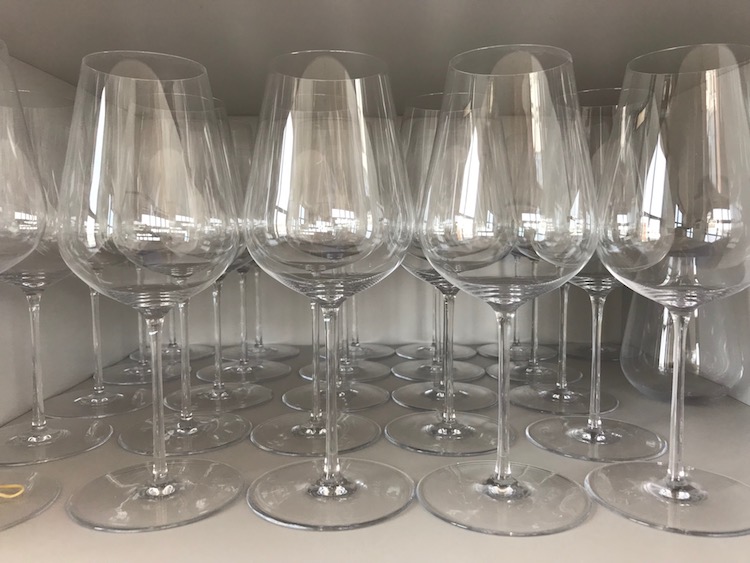My new glass and decanters

To order my glasses and decanters click here. See also where to find them.
21 June 2023 Today is the fifth anniversary of my wine glass and decanters – see JR x RB glassware turns five.
13 April 2020 French-based wine influencer Julien Miquel of Social Vignerons on our glass.
4 April 2020 Riesling guru Terry Theise on our glasses. 'Civilian' orders via richardbrendon.com (UK) or https://skurnikhospitality.com/ (US).
15 October 2019 See this lovely video assembled by our Benelux importers Vinetiq.
27 June 2019 My beautiful, hugely effective glasses can now be hired for tastings and parties in the UK. See So, so Sensible.
3 October 2018 See this guide, continually updated, to where the glassware can be found around the world.
18 September 2018 If you've already heard about my glassware and are interested in their availability, rather than plough through the full story of how the range came about and what it comprises, see here.
25 June 2018 I'm very excited to be launching a small but perfectly formed collection of wine glassware. There is just one wine glass, together with two beautiful decanters (one for young and one for old wine) and a water glass that could double as a stemless wine glass. The old-wine decanter doubles as a luxurious flask for water for those who like everything to match.

The story is that I was approached almost a year ago by a young designer Richard Brendon (below left) with quite a reputation for craftsmanship, so much so he is part of the Walpole initiative to promote British luxury goods abroad. Having made a name for himself with top-quality bone china, based on classic designs, and whisky glasses, he said he wanted to co-operate with me on a range of wine glasses.
Partly because I was about to go off to France for the summer, I rather fobbed him off, pointing him in the direction of the wine-glass specialists I admire, Zalto, Riedel and John Jenkins. But we did get together when I was back in London at the end of August and I liked him and his marketing right-hand woman Lily Colman Osborn and their approach. Because I thought it would be fun to create something perfect with these people, and was won over by their professionalism and the quality of their work, I started to think about my ideal qualities as far as wine glasses are concerned (many of which will be obvious to you if you are a committed wine lover):
- gossamer-thin glass with a particularly thin rim to put the taster in as close communication with the liquid as possible, so my glass had to be individually mouth-blown by skilful, experienced artisans
- a stem that is tall enough to allow even the big-handed to swirl comfortably without affecting the temperature of the wine, but thick enough to preclude easy breakage, and short enough to fit easily into a dishwasher and on a shelf in a normal domestic cupboard
- dishwasher-friendly (this is almost my personal number one requirement; we use so many glasses)
- a generous bowl going in towards the rim that captures the all-important aroma and allows energetic swirling to encourage it with no danger of losing any wine over the rim, but is not so wide as to make storage difficult, or measures of wine look mean
- an opening at the top that is big enough for the big-nosed but not so big that spillage would be a problem
- a capacity that yields maximum surface area with an average pour of about 125 ml
- a flat base, obvs.

I know that most wine-glass manufacturers offer a range of glasses, some of them running to dozens of different models, and all of them offering different shapes and sizes for different wines according to their colour, strength, fizziness and, often, provenance, but I am above all a pragmatist. A different glass for each different wine may increase potential pleasure by a few per cent, but who has the space to store multiple different sorts of wine glass? (And I have always had some difficulty working out which is which anyway.) I have spent 42 years trying to make wine as approachable and as pleasurable as possible and sincerely believe that just one glass for all wines makes perfect practical sense.
For a start, I see no reason at all why white wine should be served in a smaller glass than red. Some whites are more aromatic than some reds but many a white is every bit as subtle as the average red wine so needs just as much encouragement via a big bowl to express itself. And who says that we should drink smaller quantities of white wine than red?
I have also noticed in recent years that the top producers of specialist wines such as champagne and sherry really want their wines to be served in a regular wine glass, not to be corralled into a special shape or size. (See, for example. Olivier Krug's campaign against the champagne flute, and Jesús Barquín's plea to serve fine sherry in a wine glass.)
So, I proposed to Richard Brendon that, if we were to design a wine glass together, it should be just one size and shape. And – good for him – he took it on the chin. Doubtless slightly regretfully kissing goodbye to the extra profits to be made from flogging newlyweds many a different set of glasses, he has been the most agreeable man to work with – asking me only once 'are you sure?'.
Based on my sketches, and suggestions for an average pour, he came back with several prototypes and we took it from there. It was not until that point that I realised what an aesthetic perfectionist he is. He thought of all manner of details that I, a mere consumer, had never considered – such as the need to painstakingly blow the stem as part of the glass (see below) rather than assembling it separately as is the case with machine-made glasses. He was lining up various angles and curvatures that to me seemed exceptionally detailed, but I see now that all his refinements have resulted in a shape that really is immensely pleasing to the eye as well as a massive pleasure to use and handle and a real complement to wines of all sorts.

As any long-standing visitor to this site will know, I have long been an admirer of Zalto glasses and their beautifully thin, mouth-blown glass. Once you have experienced this delicacy, you really can't go back to enjoying a thicker glass. But in my capacity as wine advisor to the new Oswald's wine club in Albemarle Street, London, I came across someone who wouldn't even consider Zaltos because of their angular design. Oswald's owner Robin Birley, son of the man who started Annabel's, Harry's Bar, etc and grandson of painter Oswald Birley, is a true aesthete. For him, it's the look of everything that is the most exciting aspect of his clubs 5 Hertford Street and now Oswald's. I was quite taken aback to meet this resistance to a glass I have been using happily for some years, but it did make me think, and realise that there is a lot to be said for a classic rounded shape.
Et voilà! The Jancis Robinson x Richard Brendon wine glass:

The water glass is exactly like this but has a flat bottom rather than a stem (and we are aware that some people prefer stemless wine glasses):

And we also wanted to offer decanters as part of the range, recognising that the sort of decanter suitable for young wine is very different from what is needed for old wine. Below is the thoroughly satisfying (to eye, palate and arm) young-wine decanter. It echoes the shape of the wine glass while maximising the surface area of the wine and providing an ideal way of aerating the wine: seizing the neck and swirling it around. This works just as well as a magnum decanter too.

For old wines, decanting is needed just to separate the mature wine from its sediment and then, in many cases, one wants to minimise contact with air, so we have designed a much narrower, less generous decanter, again echoing the shape of the wine glass, with a lovely (optional) stopper depending on how fragile you feel the wine is. Without the stopper, this works beautifully as a water carafe.

The collection is being launched a week today in Harrods and orders are already being taken on richardbrendon.com (who can ship abroad) but the plan is to make it much more widely available, not just in the UK but globally. We'll be launching it formally in the US in October, and once I have finished work updating The World Atlas of Wine for its eighth edition to be published next year, I'm hoping to do a bit more travelling than I have been able to do this year, perhaps launching the range in various other likely locales.
Of course these very luxurious, handmade, mouth-blown items (made by the jolly-looking crew below), are not cheap – but they are very competitively priced compared with some other wine glasses. They also come in an extremely smart, sturdy box (designed by Richard) with a full colour booklet. Prices as below:
Box of two wine glasses £70
Box of six wine glasses £200
Box of two water glasses £50
Box of six water glasses £150
Boxed young-wine decanter £100
Boxed old-wine decanter with stopper £125
Boxed water carafe £95
I hope you get a chance to try these beauties. We are doing our best to encourage as many restaurateurs and wine-bar owners as possible to use them. I first showed them, or rather some prototypes, to wine lovers at our JancisRobinson.com Christmas dinner and their effect on many different types of wine was widely appreciated (though you may feel the testers were not completely impartial). Since then, however, we have given a wide range of wine drinkers a preview and have been delighted by the response, both to how they look and what they do for wine's taste and aroma. I have yet to find a wine that is not flattered by them. And of course I just love how thin yet sturdy they are. See these detailed technical specifications.
My heartfelt thanks to Richard, Lily – and the guys below.

Below is what my wine glass shelf looks like now. Note the elastic band on one of the prototypes in the bottom left hand corner.

Become a member to view this article and thousands more!
- 15,418 featured articles
- 274,398 wine reviews
- Maps from The World Atlas of Wine, 8th edition (RRP £50)
- The Oxford Companion to Wine, 5th edition (RRP £50)
- Members’ forum
- 15,418 featured articles
- 274,398 wine reviews
- Maps from The World Atlas of Wine, 8th edition (RRP £50)
- The Oxford Companion to Wine, 5th edition (RRP £50)
- Members’ forum
- Commercial use of our Tasting Notes
